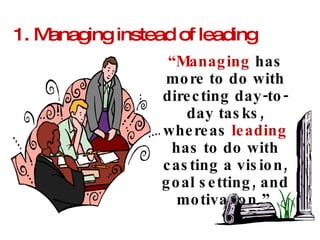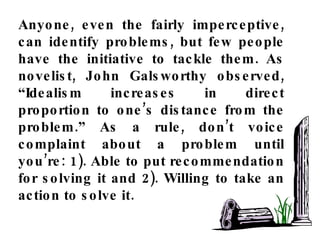Leader’s insight
- 1. Leader’s Insight: Leaders’ Top Three Mistakes
- 2. 1. Managing instead of leading “ Managing has more to do with directing day-to-day tasks, whereas leading has to do with casting a vision, goal setting, and motivation.”
- 3. In a study several years ago, two teams of leaders were given difficult problem to solve. The complex problem involved mental gymnastics, difficult decisions, and intense concentration. Both teams participated in the project in a room where….
- 4. TEAM A TEAM B ...5 minutes! ...but once each hour !
- 5. 2. Mistaking individual loyalty for team building “ The leader lets that team member go, and he just bangs against the other team member closest to him, and that one bangs quickly into the team member next to him, and so on. So all that really happens is that this one team members bangs into the others, and they swing back and forth bumping into each other.”
- 6. You, the leader, pull one of your team members away from the others and get him pumped up about a change that needs to be made. That’s like pulling one of the steel balls and holding it there. Then when you let him go, you expect him to return to the rest the team, where they will all function with superb team dynamics, solving the current problems, achieving team goals, and making changes
- 7. We shouldn’t neglect the individual relationships with those who work closely with us. We also can’t miss the important steps necessary to putting those people together in team situations where they learn what it means to work together.
- 8. 3. Failing to apply what motivates us We want our people to be competent so that everything always runs smoothly. But when we lock people into the routine of sameness, we wind up killing their motivation. When we stretch people into new areas of challenges, we know they are going to make mistakes. But when we keep them “safe,” we take the motivational wind out of their sails.
- 9. What Problems Might Principals Encounter ?
- 10. A principal might face some of the following dilemmas while managing school-community relations: School boards and administrators who are fearful of losing control. The needs to be all things to all people The need to be all things to all people. Disagreement about the meaning of community involvement. Reluctance of some teaching staff to cooperate in community involvement .
- 11. The Five Truths Leaders Understand about Problems
- 13. For the aspiring leader, problems may be the most faithful companions of all. The road to success is seldom paved smoothly, and is oftentimes under construction. Potholes and barricades abound. At every bend in the journey, a leader’s vision must peer around obstacles and through formidable walls to foresee a positive future. Leaders who sidestep problems stunt their growth- they end up shallow and debilitated. The successful leader stares down problems and resourcefully addresses them.
- 14. 2. Perspective on the problem, rather than the problem itself, determines success or failure.
- 15. We see problems, not as they are, but as we are. That’s why attitude plays such a crucial role in separating those who lead from those who follow. Alfred Armand Montapart said “ The majority see the obstacles; the few see the objectives; history records the successes of the latter, while oblivion is the reward of the former” Leaders look at problems from healthy, self- confident vantage point.
- 16. A Right Perspective Problems are solvable Problems will pass Problems are natural Problems make us better Problems challenge us Problems stretch us. A Wrong Perspective Problems are unsolvable Problems are permanent Problems are not normal Problems make us bitter Problems control us Problem stop us
- 17. 3. There’s a big difference between problem spotting and problem solving
- 18. Anyone, even the fairly imperceptive, can identify problems, but few people have the initiative to tackle them. As novelist, John Galsworthy observed, “Idealism increases in direct proportion to one’s distance from the problem.” As a rule, don’t voice complaint about a problem until you’re: 1). Able to put recommendation for solving it and 2). Willing to take an action to solve it.
- 19. 4 . The size of the person is more important than the size of the problem
- 20. You can tell the caliber of a person by the amount of opposition it takes to discourage him or her. Joke writer Robert Orben says that he once saw an add from a entertainer that read “Lion tamer- wants tamer lion.” Clearly, this performer wasn’t looking for greatness but merely for something manageable. To lead at the highest level requires wrestling wrestling with problems seemingly beyond our ability to apprehend
- 21. 5. Problems, responded to correctly, can propel us forward
- 22. Leaders are not discovered in the limelight; rather they are forged in the darkness under the heat and pressure. Leaders gain respect on difficult terrain, after taking a few blows and being shaped by the problems they encounter. As a matter of fact, courage and valor go undetected until seen through the lens of adversity.
- 23. THE END!
























